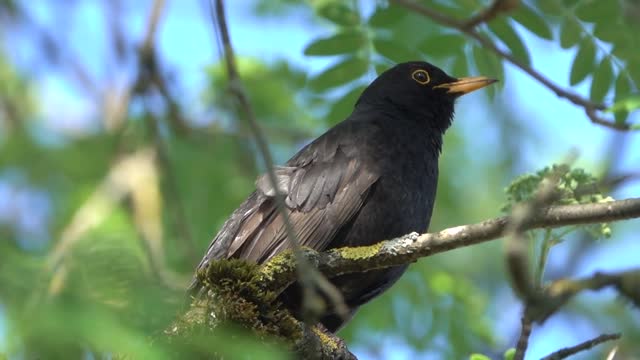Premium Only Content

blackbird is all black except for a yellow eye-ring and bill and has a rich, melodious song
The adult male of the common blackbird (Turdus merula merula which is the nominate subspecies), which is found throughout most of Europe, is all black except for a yellow eye-ring and bill and has a rich, melodious song; the adult female and juvenile have mainly dark brown plumage. This species breeds in woods and gardens, building a neat, mud-lined, cup-shaped nest. It is omnivorous, eating a wide range of insects, earthworms, berries, and fruits. Both sexes are territorial on the breeding grounds, with distinctive threat displays, but are more gregarious during migration and in wintering areas. Pairs stay in their territory throughout the year where the climate is sufficiently temperate. This common and conspicuous species has given rise to a number of literary and cultural references, frequently related to its song. The common blackbird was described by Carl Linnaeus in his landmark 1758 10th edition of Systema Naturae as Turdus merula (characterised as T. ater, rostro palpebrisque fulvis).[4] The binomial name derives from two Latin words, turdus, "thrush", and merula, "blackbird", the latter giving rise to its French name, merle,[5] and its Scots name, merl.[6] About 65 species of medium to large thrushes are in the genus Turdus, characterised by rounded heads, longish, pointed wings, and usually melodious songs. Although two European thrushes, the song thrush and mistle thrush, are early offshoots from the Eurasian lineage of Turdus thrushes after they spread north from Africa, the blackbird is descended from ancestors that had colonised the Canary Islands from Africa and subsequently reached Europe from there.[7] It is close in evolutionary terms to the island thrush (T. poliocephalus) of Southeast Asia and islands in the southwest Pacific, which probably diverged from T. merula stock fairly recently.[8] It may not immediately be clear why the name "blackbird", first recorded in 1486, was applied to this species, but not to one of the various other common black English birds, such as the carrion crow, raven, rook, or jackdaw. However, in Old English, and in modern English up to about the 18th century, "bird" was used only for smaller or young birds, and larger ones such as crows were called "fowl". At that time, the blackbird was therefore the only widespread and conspicuous "black bird" in the British Isles.[9] Until about the 17th century, another name for the species was ouzel, ousel or wosel (from Old English osle, cf. German Amsel). Another variant occurs in Act 3 of Shakespeare's A Midsummer Night's Dream, where Bottom refers to "The Woosell cocke, so blacke of hew, With Orenge-tawny bill". The ouzel usage survived later in poetry, and still occurs as the name of the closely related ring ouzel (Turdus torquatus), and in water ouzel, an alternative name for the unrelated but superficially similar white-throated dipper (Cinclus cinclus)
-
 4:04
4:04
Masterwilson
4 years agoLittle Samurang Yellow Belt Black Tip
201 -
 0:27
0:27
TNGardner
4 years agoThe Yellow Song
89 -
 0:15
0:15
kurti
4 years ago $0.01 earnedTiny yellow ducky is chasing a group of black ducklings
163 -
 2:30
2:30
slatecreekdulcimers
4 years agoYellow Jacket Longbow
132 -
 1:50:38
1:50:38
Mally_Mouse
7 hours agoSaturday Shenanigans!! - Let's Play: Mario Party Jamboree
40.5K -
 1:13:00
1:13:00
Patriots With Grit
11 hours agoWill Americans Rise Up? | Jeff Calhoun
32.9K10 -
 14:55
14:55
Exploring With Nug
11 hours ago $10.50 earnedWe Found Semi Truck Containers While Searching for Missing Man!
50.7K7 -
 27:57
27:57
MYLUNCHBREAK CHANNEL PAGE
19 hours agoOff Limits to the Public - Pt 3
108K62 -
 38:07
38:07
Michael Franzese
12 hours agoLeaving Organized Crime and Uncovering Mob in Politics: Tudor Dixon and Michael Franzese
91.6K15 -
 2:42:54
2:42:54
Jewels Jones Live ®
2 days agoAMERICA IS BACK | A Political Rendezvous - Ep. 111
73.1K48